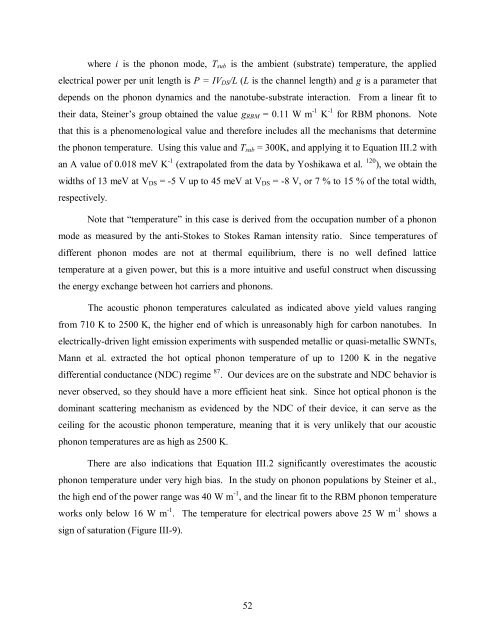Optoelectronics with Carbon Nanotubes
Optoelectronics with Carbon Nanotubes
Optoelectronics with Carbon Nanotubes
Create successful ePaper yourself
Turn your PDF publications into a flip-book with our unique Google optimized e-Paper software.
where i is the phonon mode, Tsub is the ambient (substrate) temperature, the applied<br />
electrical power per unit length is P = IVDS/L (L is the channel length) and g is a parameter that<br />
depends on the phonon dynamics and the nanotube-substrate interaction. From a linear fit to<br />
their data, Steiner’s group obtained the value gRBM = 0.11 W m -1 K -1 for RBM phonons. Note<br />
that this is a phenomenological value and therefore includes all the mechanisms that determine<br />
the phonon temperature. Using this value and Tsub = 300K, and applying it to Equation III.2 <strong>with</strong><br />
an A value of 0.018 meV K -1 (extrapolated from the data by Yoshikawa et al. 120 ), we obtain the<br />
widths of 13 meV at VDS = -5 V up to 45 meV at VDS = -8 V, or 7 % to 15 % of the total width,<br />
respectively.<br />
Note that “temperature” in this case is derived from the occupation number of a phonon<br />
mode as measured by the anti-Stokes to Stokes Raman intensity ratio. Since temperatures of<br />
different phonon modes are not at thermal equilibrium, there is no well defined lattice<br />
temperature at a given power, but this is a more intuitive and useful construct when discussing<br />
the energy exchange between hot carriers and phonons.<br />
The acoustic phonon temperatures calculated as indicated above yield values ranging<br />
from 710 K to 2500 K, the higher end of which is unreasonably high for carbon nanotubes. In<br />
electrically-driven light emission experiments <strong>with</strong> suspended metallic or quasi-metallic SWNTs,<br />
Mann et al. extracted the hot optical phonon temperature of up to 1200 K in the negative<br />
differential conductance (NDC) regime 87 . Our devices are on the substrate and NDC behavior is<br />
never observed, so they should have a more efficient heat sink. Since hot optical phonon is the<br />
dominant scattering mechanism as evidenced by the NDC of their device, it can serve as the<br />
ceiling for the acoustic phonon temperature, meaning that it is very unlikely that our acoustic<br />
phonon temperatures are as high as 2500 K.<br />
There are also indications that Equation III.2 significantly overestimates the acoustic<br />
phonon temperature under very high bias. In the study on phonon populations by Steiner et al.,<br />
the high end of the power range was 40 W m -1 , and the linear fit to the RBM phonon temperature<br />
works only below 16 W m -1 . The temperature for electrical powers above 25 W m -1 shows a<br />
sign of saturation (Figure III-9).<br />
52
















